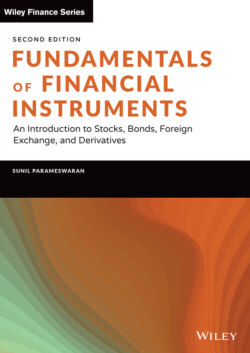Читать книгу Fundamentals of Financial Instruments - Sunil K. Parameswaran - Страница 52
На сайте Литреса книга снята с продажи.
THE EUROCURRENCY MARKET
ОглавлениеThe development of the Eurocurrency market was one of the early factors in the growth of international investment. A eurocurrency is a freely traded currency deposited in a bank outside its country of origin. For example, Eurodollars are dollars deposited outside the United States while Euroyen are yen deposited outside Japan. The term euro refers to the fact that the funds are placed with an institution outside the country to which the currency belongs. The institution need not be located in Europe. While London, Zurich, and Frankfurt are major financial centers for such deposits, so are Singapore, Tokyo, and Hong Kong in the Far East, and Dubai and Bahrain in the Middle East.
The rapid growth of the Eurodollar market can be attributed to the following factors.
After World War II the US dollar became the preferred currency for international trade, displacing the British pound, which was the primary vehicle for commercial transactions prior to the war.
All countries sought to keep dollar balances to finance their imports. The former Warsaw Pact countries (satellites of the Soviet Union) were no different. However, they were reluctant to hold dollars with banks in the United States. A cold war was going on, and there was a legitimate fear that such deposits could be impounded by the US government. Thus, these countries began depositing their dollars with European banks. As trade grew, the European banks soon discovered that there was a ready demand for these dollars by parties based outside the United States. As a consequence, an active Eurodollar market came into existence.
Due to capital market controls imposed by the US government. In the 1960s, through a legislation called regulation Q, the US government imposed low interest rate ceilings on US banks, and simultaneously imposed significant reserve requirements.
An interest ceiling meant that banks could not offer depositors more than the rate that had been mandated by the law, even if prudent business practices required them to do so. The implications of bank reserves may be explained as follows. When a unit of currency is deposited with a bank, only a fraction of it can be lent out. The balance has to be kept either in the form of approved securities or as cash. This amount is known as a reserve. The lower the reserve ratio, the more will be the money available with the bank for commercial lending. Consequently, the lower the reserve ratio, the higher will be the rates paid on deposits and the lower will be the lending rates, for the larger the amount of funds available for lending, the smaller will be the net interest margin that banks can afford to operate with.
As a consequence of these two factors, depositors became reluctant to park their funds with American banks, for these institutions could not offer attractive interest rates. At the same time, borrowers too were disenchanted, for the rates on loans were very high.
Lack of government regulations on Eurodollar deposits: Eurodeposits are relatively unregulated. For instance, the Federal Reserve, which is the central bank of the United States, does not regulate dollar deposits maintained outside the borders of the United States. Besides, such deposits do not suffer from statutory reserve requirements. Even if there is no statutory reserve requirement, however, banks by themselves usually maintain voluntary reserves as a measure of caution.
Due to the large flow of Petrodollars into international banks from the Oil Producing Export Countries (OPEC): There was a war in the Middle East in 1973 after which the oil-exporting countries recognized the full worth of their oil reserves as an economic weapon. Rising crude oil prices ensured that these countries were flush with funds, and the Euromarket, due to its lack of reserve requirements, and relatively low cost of operation due to economies of scale, was instrumental in recycling these so-called Petrodollars.
